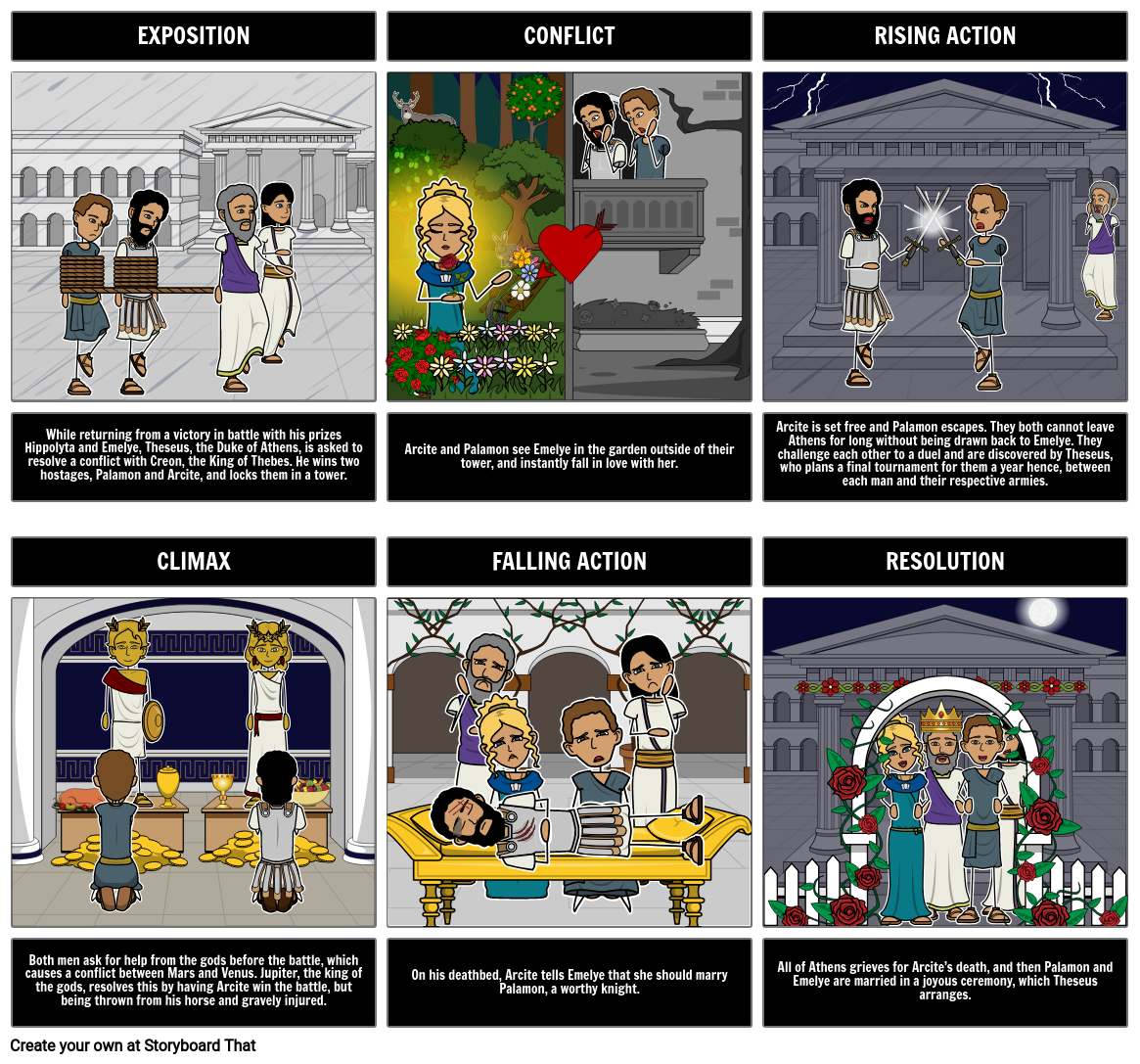Activity Overview
A common use for Storyboard That is to help students create a plot diagram of the events from a story. Not only is this a great way to teach the parts of the plot, but it reinforces major events and help students develop greater understanding of literary structures.
Students can create a storyboard capturing the narrative arc in a work with a six-cell storyboard containing the major parts of the plot diagram. For each cell, have students create a scene that follows the story in sequence using: Exposition, Conflict, Rising Action, Climax, Falling Action, and Resolution.
Example "The Knight's Tale" Plot Diagram
Exposition
While returning from a victory in battle with his prizes Hippolyta and Emelye, Theseus, the Duke of Athens, is asked to resolve a conflict with Creon, the King of Thebes. He wins two hostages, Palamon and Arcite, and locks them in a tower.
Conflict
Arcite and Palamon see Emelye in the garden outside of their tower, and instantly fall in love with her.
Rising Action
Arcite is set free and Palamon escapes. They both cannot leave Athens for long without being drawn back to Emelye. They challenge each other to a duel and are discovered by Theseus, who plans a final tournament for them a year hence, between each man and their respective armies.
Climax
Both men ask for help from the gods before the battle, which causes a conflict between Mars and Venus. Jupiter, the king of the gods, resolves this by having Arcite win the battle, but being thrown from his horse and gravely injured.
Falling Action
On his deathbed, Arcite tells Emelye that she should marry Palamon, a worthy knight.
Resolution
All of Athens grieves for Arcite’s death, and then Palamon and Emelye are married in a joyous ceremony, which Theseus arranges.
Template and Class Instructions
(These instructions are completely customizable. After clicking "Copy Activity", update the instructions on the Edit Tab of the assignment.)
Student Instructions
Create a visual plot diagram of one of the Canterbury Tales.
- Separate the story into the Exposition, Conflict, Rising Action, Climax, Falling Action, and Resolution.
- Create an image that represents an important moment or set of events for each of the story components.
- Write a description of each of the steps in the plot diagram.
Lesson Plan Reference
- [ELA-Literacy/RL/9-10/2] Determine a theme or central idea of a text and analyze in detail its development over the course of the text, including how it emerges and is shaped and refined by specific details; provide an objective summary of the text
- [ELA-Literacy/RL/9-10/3] Analyze how complex characters (e.g., those with multiple or conflicting motivations) develop over the course of a text, interact with other characters, and advance the plot or develop the theme
- [ELA-Literacy/RL/9-10/5] Analyze how an author’s choices concerning how to structure a text, order events within it (e.g., parallel plots), and manipulate time (e.g., pacing, flashbacks) create such effects as mystery, tension, or surprise
Rubric
(You can also create your own on Quick Rubric.)
| Proficient 25 Points | Emerging 21 Points | Beginning 17 Points | Try Again 13 Points | |
|---|---|---|---|---|
| Descriptive and Visual Elements | Cells have many descriptive elements, and provide the reader with a vivid representation. | Cells have many descriptive elements, but flow of cells may have been hard to understand. | Cells have few descriptive elements, or have visuals that make the work confusing. | Cells have few or no descriptive elements. |
| Grammar/Spelling | Textables have three or fewer spelling/grammar errors. | Textables have four or fewer spelling/grammar errors. | Textables have five or fewer spelling/grammar errors. | Textables have six or more spelling/grammar errors. |
| Evidence of Effort | Work is well written and carefully thought out. Student has done both peer and teacher editing. | Work is well written and carefully thought out. Student has either teacher or peer editing, but not both. | Student has done neither peer, nor teacher editing. | Work shows no evidence of any effort. |
| Plot | All parts of the plot are included in the diagram. | All parts of the plot are included in the diagram, but one or more is confusing. | Parts of the plot are missing from the diagram, and/or some aspects of the diagram make the plot difficult to follow. | Almost all of the parts of the plot are missing from the diagram, and/or some aspects of the diagram make the plot very difficult to follow. |
More Storyboard That Activities
Canterbury Tales, The
© 2024 - Clever Prototypes, LLC - All rights reserved.
StoryboardThat is a trademark of Clever Prototypes, LLC, and Registered in U.S. Patent and Trademark Office









